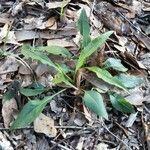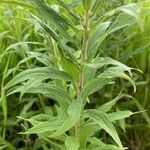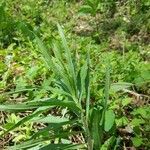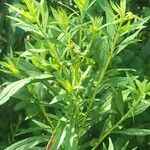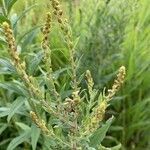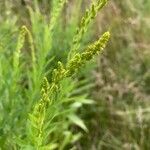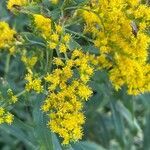Plants 50–200 cm; rhizomes short-to long-creeping. Stems 1–40+, usually short-hairy throughout, sometimes proximally glabrescent. Leaves: basal 0; proximal cauline usually withering by flowering; sessile or subpetiolate, tapering to bases; blades oblanceolate, 95–150 × 16–20 mm, relatively thick and firm, entire to serrate along distal 1 / 2 , strongly 3-nerved, apices acute to acuminate, abaxial faces finely strigose, more so along nerves, adaxial ± scabrous; mid to distal cauline blades oblanceolate (proximally) to lance-olate (distally), mid (30–)45–100(–170) × (5–)7–16(–25) mm, much reduced distally [(15–)25–55 × (3–)4.5–10(–17) mm], margins finely serrate (teeth 0–6(–14) per side on mid), distally usually becoming entire or remotely serrulate, adaxial faces ± scabrous, abaxial moderately strigillose, densely villoso-strigillose along nerves, distal sometimes minutely stipitate-glandular. Heads (15–)100–1200+, secund, in secund, pyramidal, paniculiform arrays, branches divergent and recurved, sometimes ascending-divergent, sometimes merely club-shaped thyrsiform in small plants, 5–30 × 2–25 cm (often 1.5–2 times as long as wide in southern plants). Peduncles 1–3.5 mm, moderately densely short hispiduloso-strigillose, sometimes minutely stipitate-glandular; bracteoles linear, sometimes minutely stipitate-glandular. Involucres narrowly campanulate, 2.5–4.5 mm. Phyllaries in ca. 3 series, strongly unequal; outer lanceolate, acute, inner linear-lanceolate, margins rarely minutely stipitate-glandular, apices acute to obtuse. Ray florets (5–)8–13(–17); laminae 0.7–1.5(–2) × 0.1–0.4(–0.5) mm. Disc florets (2–)3–6(–9); corollas usually 2.3–3.6 mm, lobes 0.5–0.9(–1.2) mm. Cypselae (narrowly obconic) 0.5–1.5 mm, sparsely to moderately strigillose; pappi 2.5–3.5 mm.
More
Herbs, perennial; rhizomes creeping, branched. Stems erect, to 250 cm tall, simple, shortly and softly aqua-rose downy. Leaves numerous, lanceolate or linear-lanceolate, 5-12 cm, tapering at both ends, apex acuminate, margin of lower leaves sharply serrate, of basal leaves sometimes entire, of upper leaves entire, with 3 longitudinal veins, of which 2 lateral veins protrude weakly, glabrous or downy abaxially, shortly pilose adaxially. Capitula in paniculiform synflorescences, capitula attached on one side, branches curved downward. Involucre 3-4 mm; phyllaries linear-lanceolate, slightly obtuse. Florets golden yellow; ray florets hardly longer than involucre. Pappus inner (longest) bristles not obviously clavate. Fl. Aug-Sep.
Dry to damp thickets, roadsides and clearings. Dry to moist soils, fields, roadsides, disturbed areas from sea level to 1000 metres.
